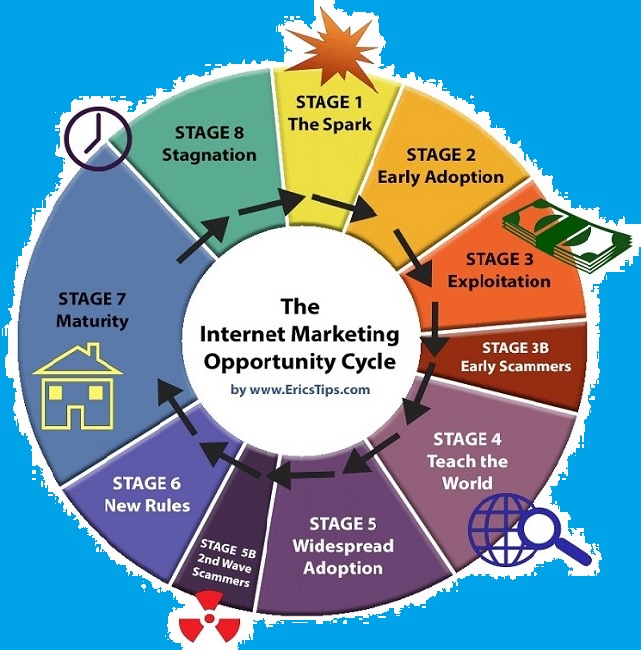This blog article is submitted as a “Guest Blogger” article by Eric Holmlund. I have been following Eric for several years and find him to be a very principled and honorable online marketer. I trust and respect his insight and opinion stated in this blog.
As someone who has been involved in Internet marketing for 20 years, I’ve observed a few trends.
One trend is the cycle of hype and disillusionment among participants in the industry, especially newcomers. It is a very frustrating and disheartening experience for many newbies. They start with such hope and excitement about a business opportunity, but that elation degrades into disappointment and then often anger. This cycle has created a lot of jaded Internet marketers.
In turn, many blanket statements are made about the industry and business opportunities in general, like “they’re all scammers,” “it’s rigged,” and “the gurus don’t want you to win.”
As I was reflecting on some of the responses to my recent State of the IM Industry article (2019), it occurred to me that relative newcomers probably aren’t aware of the cyclical nature of the IM industry that I take for granted. I then realized that I’ve never really explained this cycle in one cohesive article, nor have I seen any articles or graphic representations that capture its nuances.
So here’s my attempt to do that, and I’m calling it the “Internet Marketing Opportunity Cycle.” (Shown above)
“I believe by understanding this cycle, and being able to determine where any given opportunity is currently positioned, you can set more realistic expectations, avoid the pitfalls that come with certain stages of the cycle, and be more intentional with your business planning.”
STAGE 1: The Spark (New Technology/Platform)
The beginning of the cycle is sparked by some sort of new technology or perhaps more often an innovation of existing technology. Frequently it could be classified as what I consider to be a “platform”. It could be very broad based, such as the invention of the Internet, or mobile phones. More frequent are the smaller innovations such as a new social media platform, or a new advertising platform within an existing social media site (such as Facebook Ads). The one commonality that virtually all of these innovations share is an aspect of communication, which can be used for marketing purposes.
The “opportunity” is to use the platform to generate traffic, leads, sales, or otherwise profit in some way. Not all Internet marketing-related products are “opportunities”. Some products are tools and materials designed for certain business models, and are not opportunities on their own. In those cases, you may want to determine and evaluate the underlying opportunity if it’s not self evident. If a particular tool (such as a software program) is designed specifically to generate traffic/leads/sales, then it would probably fit within this opportunity cycle. If a product involves training to get traffic/leads/sales, then I would consider that product to be opportunity based.
STAGE 2: Early Adoption
Innovative marketers jump in as early adopters, and begin to use the new platform. At first they might just be participants, learning the platform along with everyone else. Those who are constantly looking for new ways to generate traffic, leads, and sales will push the cycle into Stage 3. Some good examples could be the early days of Twitter, or Instagram. Marketers joined and basically started doing what everyone else was doing. Tweeting about random stuff. Posting pictures. Following others and gaining a following. No one had a focused marketing plan yet, and no one was getting paid to tweet. But that all changed very quickly.
STAGE 3: Exploitation
The savvy early-adopting marketers will exploit the new opportunity to generate as much benefit for themselves as fast as possible. If you have a negative connotation of the word “exploit”, then capitalize might be a better word to understand this phase. The marketers doing the exploiting are generally not doing anything wrong or unethical (although there are always exceptions). They are chiefly opportunists. A lot of money may be made quickly, and this is where some marketers literally do “get rich quick.” Because of that, it can be great to be an early adopter as a marketer. However, it also comes with risks, and may result in a short-lived business. The length of this stage is highly variable, but my observation is that in general it keeps getting SHORTER with each new spark. I believe the reason for that is the proliferation of information marketing, wherein Stage 5 is brought about sooner by marketers who are focused on making money by teaching these exploitation methods. For example, when Google AdWords first came out, the early adopting affiliate marketers quietly exploited it for a couple years before spilling the beans. When Facebook Ads came out, it was a matter of months.
STAGE 3B: Early Scammers
Whenever successful (profitable) exploitation of a new technology occurs, you can be sure there are a few scammers close behind. While some scammers are truly innovative, the vast majority are not. Instead they watch the smart marketers and mimic them. This stage may be be practically unobservable because only a few scammers are involved at this point, but in rare cases the scammers can be so detrimental that it causes the cycle to skip directly to Stage 6. I called this Stage 3B, because it happens concurrently with Stage 3, and is not so much a stage unto itself but is a typical occurrence within the cycle.
STAGE 4: Teach the World
Sometimes this happens naturally because there are good people in the business who simply want to help others by sharing the opportunity. Other times some of the early adopters sense that the prime window of opportunity is closing, so they move on to the next phase of exploiting the opportunity which for them is making money by teaching it to others. Again, even if profit is the objective, teaching is usually not an unethical business model. This is in fact one of the areas in which I have focused and profited over the years. The problems often come in when marginally successful (or even unsuccessful) marketers begin teaching things they’re not qualified to teach, and when the unscrupulous marketers (borderline scammers) begin making unreasonable or flat-out false claims in their advertising. For example, suppose someone made $200 on the Teespring platform (a legit opportunity which became an IM fad a few years back, and well illustrates this entire cycle), and immediately decides to start coaching it. That kind of stuff happens all the time in the IM industry.
STAGE 5: Widespread Adoption
The opportunity reaches a tipping point, and the masses jump into it. Competition fills the opportunity, and success becomes more difficult due to the competition. For example, it may become more expensive to advertise, or simply more difficult to get prospects’ attention. It is important to realize that this is the point at which most “internet marketers” jump into the game! This marketer influx may be the result of big infoproduct launch or other efforts made by “gurus” to teach the opportunity. Along with that comes a lot of HYPE. The disillusion then comes quickly, as the opportunity isn’t as easy as it was proclaimed to be, and in fact that’s usually because the effectiveness of the methods being taught are devolving in real time. At the same time that Internet marketers are jumping into it, mainstream businesses are also jumping in. Everything from offline mom-and-pop shops doing advertising, to Fortune 500 companies launching branding campaigns. Once the world realizes that the money is here, everyone wants a piece of it, which accelerates the growth of competition.
STAGE 5B: 2nd Wave Scammers
As the world adopts the new platform and it becomes well known as a source of profit, another wave of scammers will come in. These are not the “smart” ones who are closely following the early adopters. These ones are basically lazy and nefarious marketers who don’t have much creativity and follow the pack of sheep into what seems to be working, and they make a mess of it.
STAGE 6: New Rules
In this stage, new rules, restrictions, and obstacles are introduced as a result of Stage 5 and 5B. Often this is a reactionary movement from the owner of the platform as a result of degradation of the “user experience”. In other words, the proliferation of marketers, marketing, and scammers have combined to make it not such a nice platform anymore. In some cases, these changes result in the proverbial baby being thrown out with the bath water. Internet marketers are often the first to get kicked out, because they’re lumped in with the scammers (because again, the scammers are basically imitating legit marketers). These changes typically make the opportunity more difficult, but that’s not necessarily a bad thing in the long run. Platforms that successfully implement effective changes are then able to sustain long term businesses. I could cite many examples of this stage, but one that I see starting to happen right now is with the use of chatbots. Chatbots have been one of the hottest marketing tools for the past couple years, and have created big results for many marketers. Now as the world has jumped on the trend, Facebook is poised to start controlling and limiting their use for marketing, and I think we’ll see changes in the near future that impact marketers.
STAGE 7: Maturity
After going through some evolution, the opportunity reaches a level of maturity wherein things become more stable and predictable. The length of this stage can be extremely variable. In some platforms, it’s over almost as soon as it started. An example of that would be Periscope, which just a few years ago was touted as the hot new marketing platform. While there are probably some niche marketers out there with a following, I personally don’t know anyone who is benefiting from Periscope these days. It blasted through this entire opportunity cycle in about a year. Other platforms can last a long time, by Internet marketing standards. Some may outlast our businesses, and some may outlast our lifetimes. Ebay is a platform that I started selling on in 1999, and I still sell on it today. I expect it will still be around in another 10 or 20 years. The Internet itself is an example of a platform that will probably outlive us, meaning that the Internet is not an unwise place to build a business.
While there are certainly benefits of getting into any opportunity at the earliest possible stage, this Maturity Stage is generally the “safe” time to get into an opportunity as a long term business. It’s more stable, which means you can plan for the long term. It’s more predictable, which means you have less risk of your business being wiped off the map by a new rule or update. There is no get-rich-quick in this stage. Yet even within this stage of maturity, change is inevitable, and the ability to adapt is vital.
STAGE 8: Stagnation
At some point, the opportunity stagnates and gradually becomes less effective. Again this stage can vary greatly in length. In the technology world, this will inevitably lead us back to the start. A new spark, with new opportunities, will arise. That’s why I view this as a cycle and not merely a linear timeline. I would argue that a current example of stagnation is Twitter, with its reportedly lackluster numbers, and dwindling efficacy.
So there you have it. I think I just coined the term, because I did a Google search for “Internet marketing opportunity cycle” in quotes, and there were ZERO results
What to take away from this article:
– As you evaluate any opportunity, be aware of its current stage in this cycle.
– If you’re looking to get rich quick (which is a higher risk business strategy that I don’t necessarily recommend), you need to focus on identifying Stage 1 opportunities at the moment of the spark.
– Be especially aware of Stage 4-5 opportunities, because those are the ones that are getting the most hype and attention. It doesn’t mean you shouldn’t jump into it, as it’s still often better sooner than later, but set your expectations accordingly, and realize you will not inherently achieve the same results as the person teaching it.
– Realize that changes and new rules especially on new and developing platforms are the norm. If you’re averse to change and risk, then you might not want to be an early adopter.
– If you like to play it “safer” and plan your business for the long term, look at Stage 7 mature platforms that have the potential to outlive your objectives.
– We can also infer from this cycle that one of the biggest opportunities, while not easily accomplished, is to BE the spark. Build the next platform. Innovate the next opportunity. Most fail at this, but those who succeed profit immensely.
Let me know what you think. In the comments below, tell us about your experience with this cycle, and opportunities that you’ve observed or participated in. I approve comments periodically, so your comment won’t appear instantly.
Thanks for reading, and have a great day!
Eric Holmlund
tips@ericstips.com



